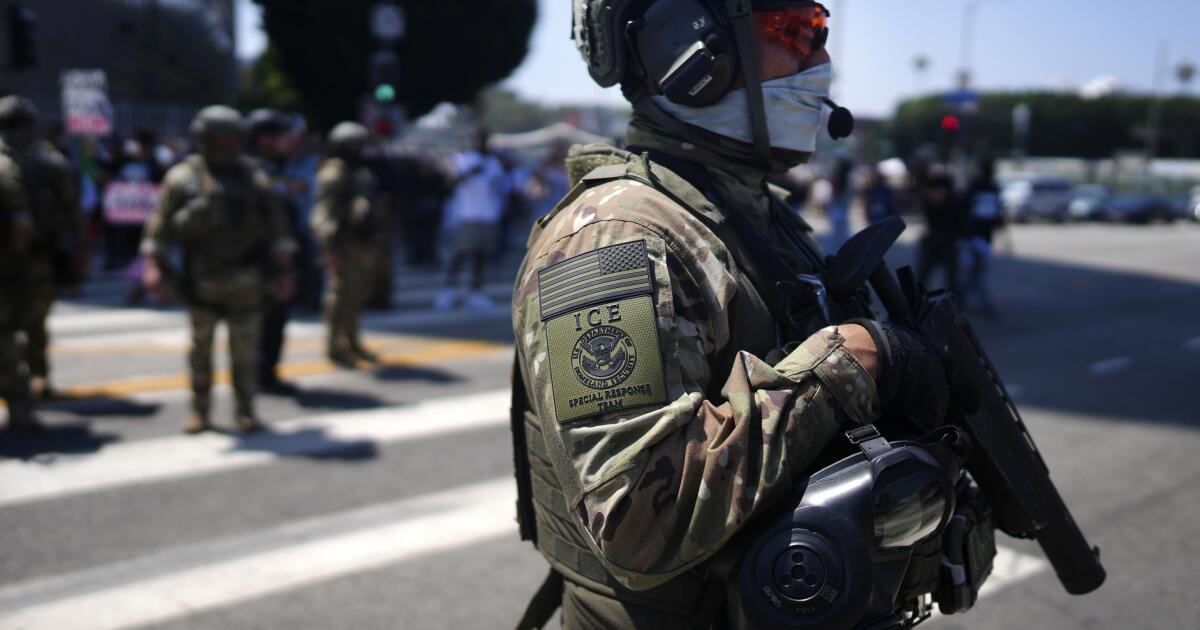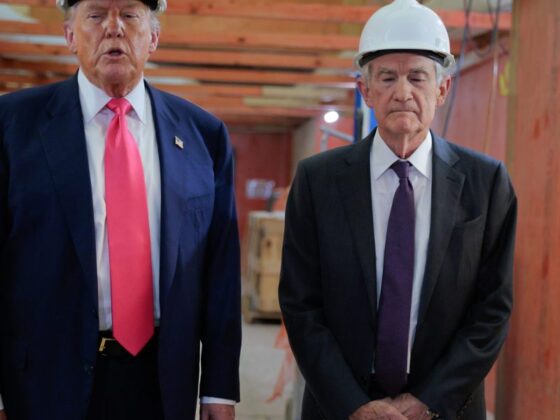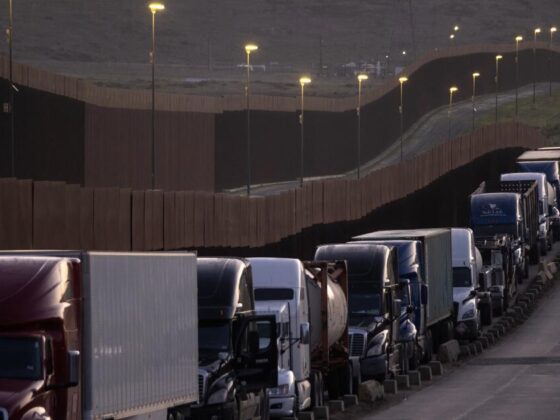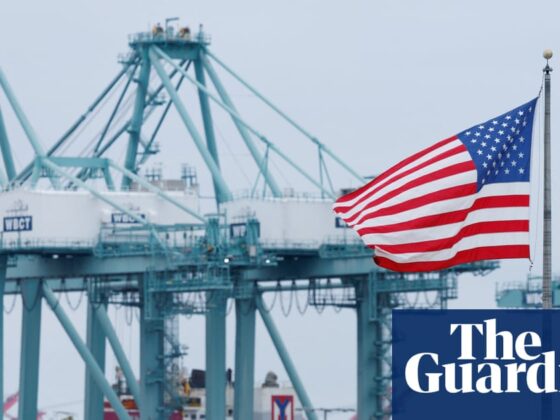As the crackdown on undocumented workers in California approaches a third month, researchers say the effects on the state’s economy are already showing.
Since early June, Los Angeles has been roiled by the Trump administration’s immigration sweeps. The raids rendered some L.A. neighborhoods ghost towns, with businesses shuttered and customers few and far between, as people stayed home out of fear of being targeted.
Even as mass street arrests appear to have slowed, economists warn that continued disruptions could hobble many businesses that rely on immigrant labor. Even those not reliant could see ripple effects, as a lack of such labor disrupts productivity and delays projects, weighing on California’s gross domestic product and causing increases in food prices for the rest of the United States.
“If it’s true that we are going into a phase in which a lot of these workers are either deported, or scared enough that they won’t go to work, this will be a massive impact,” said Giovanni Peri, an international economics professor at UC Davis.
Of course, the state’s economy is massive — the equivalent to the fourth largest in the world if it were a country — so it would take a lot to derail it. But the Immigration and Customs Enforcement raids are targeting a crucial motor to the Golden State’s success. Economists and business leaders are starting to gather indicators of the actual effects.
“My gut check is, this is bad,” said Todd Sorensen, a professor in the economics department at UC Riverside. “We will need to see how these trends continue over the rest of the summer.”
One of the first bits of macroeconomic evidence to come in suggests an unusually large number of people didn’t go to work when the raids began.
An analysis of U.S. census data from late May and early June by researchers with UC Merced’s Community and Labor Center found that the number of people reporting to work in the private sector in California decreased by 3.1% — a downturn so significant it is only recently matched by the period when people stayed home from work during the COVID-19 lockdown.
In the rest of the country, the number reporting to work in the private sector increased.
California’s rate of decline in work was highest among noncitizen women, with a loss of about 8.6%, or 1 in 12 women not reporting to work. But, notably, citizens also showed a marked decline.
“If people are afraid to leave their house, they aren’t spending money, which generates less business,” said Edward Flores, associate professor of sociology and faculty director of the UC Merced labor center. “There should be a lot of concern for the downstream effects.”
Economists say the work that undocumented immigrants do has a multiplier effect. Their work output generates other jobs. Take a construction site, for example. If immigrant workers are hired as brick layers, their work supports hiring supervisors, engineers, electricians, plumbers and others.
If the undocumented workforce shrinks, job opportunities for U.S.-born workers could dry up as well, and wages could deflate, if past studies of the effect of targeted mass raids are any indication.
“Immigrant workers are the backbone of the economy,” said Michael Clemens, an economist with the Peterson Institute for International Economics.
A June report from the Bay Area Council Economic Institute found that, based on their wage contributions to the economy alone, undocumented workers generate nearly 5% of California’s gross domestic product. That proportion rises to 9% when ripple effects of their labor are added.
With 2.28 million undocumented immigrants living in California, they represent 8% of workers in the state. And the population has deep roots, with nearly two-thirds having lived in the state for over a decade. Their total contribution in local, state and federal taxes is $23 billion annually, according to the Bay Area Council Economic Institute.
If California’s undocumented workers were erased from the economy, researchers calculated the state’s agricultural industry would contract by 14% and the construction industry would shrink by nearly 16%. The study projects a loss of $278 billion to California’s economy as the upper figure of the financial damage.
These numbers represent the most drastic scenario. It’s difficult to know what the actual toll will be, said Abby Raisz, of the Bay Area Council Economic Institute: “That’s the million-dollar question.”
How long the raids persist matters, said economist Christopher Thornberg of Beacon Economics. Take the example of a power outage, Thornberg said. If there’s a power outage for two days, that’s not a loss of two days of economic activity, since people just catch up on missed shopping and other activities.
“It is business delayed, not business canceled,” he said in an email. “If the blackout goes for two months — well, now we can assume some of it will end up being business lost, and that’s when the real economic impacts start to creep in,” Thornberg said.
There are some industries in which the effects are clear, Thornberg said, citing car washes, which have been raided repeatedly.
Early reports from farmers are also not optimistic, with groups reporting severe labor shortages during peak harvesting season for many crops.
Bryan Little of the California Farm Bureau described how a strawberry producer in Ventura County lost most of his crop after workers stayed home. Little said these labor shortages are becoming more frequent and could drive up prices sharply on the produce California ships to the rest of the country.
“People were terribly upset over the price of eggs in the fall and winter,” Little said. “It’ll be interesting to see when you start getting prices like that on virtually every item.”
Local hotels and other businesses that rely on tourism are bracing for adverse effects. Their customers are getting scared away by the raids. These businesses are also exposed to potential labor shortages because they are heavily reliant on the immigrant workforce.
Visit California, the state’s marketing agency, in May projected international visits would decline by 9.2% in 2025, due to negative sentiment toward the Trump administration’s trade policies.
Assemblymember Sharon Quirk-Silva (D-Fullerton), whose district covers swaths of northern Orange County, said there has been low turnout at summer concerts, area car shows and other events. She described deserted city centers in downtown Santa Ana and low foot traffic in Little India in Artesia.
Artesia’s mayor, Ali Taj, said the impact on the city’s sales tax revenue is going to be “horrific.”
“The message here is please stop, stop, stop,” he told a news conference at Buena Park City Hall, where local officials and business leaders discussed the effects of the raids. “Enough is enough.”
Downtown L.A. business groups have said the Fashion District has seen a 30% drop in traffic.
“It will help tremendously when there are reduced ICE operations,” said Nella McOsker, president and chief executive of the Central City Assn., which represents the interests of more than 300 businesses, trade associations and nonprofits. “That will help at least all of us who care about downtown to be in a position [where] we can change perception and really call for people to come back.”
The Hispanic Construction Council estimates the country was already dealing with a nationwide construction workforce shortage of 500,000 workers. George Carrillo, chief executive of the council, said that construction projects were 14% behind schedule when Trump took office, but that lag has grown to 22% under the Trump administration, as deportation threats have weakened the workforce.
Further labor shortages in the construction industry, in which the workforce is 61% immigrant and 26% undocumented, will hinder wildfire recovery in Los Angeles and work on other critical infrastructure across the U.S., including levies, bridges and dams, Carrillo said. In California, major airport expansion projects are planned in Sacramento and Los Angeles, as well as new soccer stadiums and medical centers.
Undocumented workers do not have political representatives, so the business leaders that depend on their hard work need to stand up and let the White House know the economic cost, Carrillo said.
“When it came to tariffs and it was affecting the auto industry, guess what, the Big Three [automakers] called the president and said ‘You need to stop this.’ And he did, and he backed off of the tariffs,” he said. “It’s the same thing here, but for some reason, we feel like we can’t stand up.”













